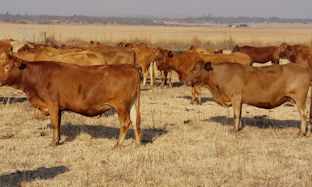
What livestock farmers need to know about climate change
by Dr Louis du Pisani
Photo: Tumiso, Pixabay
The agricultural press is full of doom-and-gloom stories about climate change, with little advice on whether the perceived negative effects can be mitigated, and if so, what are the management adaptations livestock farmers need to implement.
There are two schools of thought when it comes to climate change: the believers and the sceptics. Change (read as variability) in the earth’s climate has been with us since the dawn of time. So, it is really irrelevant on which side the reader of this article is. What is relevant, though, is to know in what phase of the change or variability of the climate we are, as that will determine what mitigation measures need to be put in place by farmers.
Before one can start a debate on how to adapt to a variable or changing climate, it is important to take note of the climate fluctuations that have been predicted over the last 30 to 40 years and which of these predictions have finally realised or are realising. There were broadly three major predictions of the changing climate that have relevance to the current generation of livestock farmers.
The first prediction was that the world would become warmer. The latest measurements show that the average annual temperature over Southern Africa has increased by about 1°C over the recent past. This prediction thus seems to be coming true and farmers will have to plan for it.
The second prediction was that the quantity and distribution of rainfall would change, with an initial expectation that the western parts of the RSA would become drier and the eastern parts wetter, and that more extreme weather patterns could be expected.
The latest scientific observations show a marginal decrease in rainfall during the autumn months over the central and north-eastern parts of the RSA, but the annual total rainfall has not changed significantly.
Another observation is that the average number of rainy days per year has decreased over the central and north-eastern areas. If the total rainfall remained the same but the number of rainy days decreased, it is logical that the rainfall intensity increased and that the wetter periods become wetter and the dry periods drier. Thus, the prediction of more extreme weather conditions seems to be realising, and farmers must take that into consideration in their management plans.
There is currently no consensus among scientists on the future changes in rainfall patterns across South Africa.
Since the early 1800s, the CO2 concentration in the earth’s atmosphere has increased from about 275 parts per million (ppm) to over 400 ppm and it is still rising. There have been similarly high levels of CO2 in the geological history of the earth, but these are actually irrelevant in terms of the current situation. What is relevant, is that the current generation of farmers are experiencing high levels of carbon dioxide and they must consider that in their management systems.
A very popular prediction is that climate change will cause more extremes in weather patterns. Photo: enriquelopezgarre, Pixabay.
Debate 1: What are the consequences of the increased CO2 levels for livestock farmers?
Plants absorb carbon dioxide and utilise it for plant growth through the process of photosynthesis. Carbon, along with hydrogen and oxygen, makes up about 96% of the dry mass of plants. One can therefore expect that with more CO2 in the atmosphere, plants will grow better. The latest field research indicates an average increase of 17% in above-ground plant production and about 30% in root growth due to the higher atmospheric CO2 concentrations on earth.
There are a few factors that regulate the effectivity of the increase in plant growth due to increased CO2 in the atmosphere. The first factor is the specific photosynthetic pathway of the plant. There are three types, namely C3 (Produces 3-phosphoglyceric acid (PGA) or 3-carbon acid as the first product during the CO2 fixation), C4 (Produces oxaloacetic acid (OAA) or 4-carbon compound as their first stable product) and CAM (Collects CO2 in arid conditions during night time by a process called Crassulacean acid metabolism). Cool season plants follow the C3 pathway and include plants like shrubs, trees and cool season grasses. Tropical plants, such as tropical grasses, follow the C4 process, while succulents follow the CAM route.
It is mainly the C3 plants that are most favoured by an increase in CO2 levels, while C4 plants’ response is less than half as well. Nevertheless, increased CO2 levels benefit both C3 and C4 plants’ production. This is known as CO2 fertilisation.
The second factor that plays a role in the response to CO2 fertilisation is the availability of nitrogen. A lack of nitrogen limits the CO2 growth response, while good N provision enhances the effect. Consequently, C3 legumes like thorn trees are particularly favoured by the increased atmospheric CO2 concentrations, which leads to increased bush encroachment.
Thirdly, increased CO2 levels improve the water use efficiency (WUE) of plants. Carbon dioxide is absorbed via plants’ stomata. When the stomata open to absorb the carbon dioxide, the plant loses water to the atmosphere. With higher carbon dioxide concentrations in the atmosphere, a plant can absorb high quantities of CO2 through stomata that are less open and a resultant lower loss of water to the atmosphere. This then leads to the improved WUE. Increases of between 5% and 20% are reported in the literature.
One observation on climate change is that the total rainfall will stay the same, but the rainy days will decrease. Image: Linda Russ, Pixabay.
The negative outcomes of CO2 fertilisation and how to deal with it
Carbon dioxide fertilisation increases bush encroachment. The South African Environmental Observation Network has reported dramatic changes in the botanical structure of the savanna, grassland and fynbos biomes of South Africa over the past 100 years. According to them, the savanna areas are expanding into the adjacent grassland areas, while the existing savanna areas are experiencing a marked increase in bush densities. In fact, it is turning into so-called thickets that are almost impenetrable to humans and animals. These changes are even observed in the drier savanna areas.
The grasslands bordering the savanna biome are being invaded by trees and shrubs, while the rest of the area of the grassland biome experience increased densities of smaller bushes and shrubs, for example Adder bush (bankrupt bush). Even the drier grassland areas are not excluded.
In parts of the fynbos areas, the increase of alien invasive plants such as red wreath acacia, pine trees and wattles takes place.
Savanna and grassland are estimated to provide about 81% of the total available grazing capacity from veld in the RSA (37% in the savanna biome and 44% in the grassland biome according to Paul Avenant of the Department of Agriculture). Managing the bush encroachment problem is therefore a very high priority in these areas. In the savanna areas, farmers lean towards game farming as a means of relieving the problem, but the success of this strategy is questionable as only the so called mega browsers, such as elephants and rhinos, have a significant suppressive effect on brush. That leaves most livestock farmers with only two possible management tools: fire and herbicides (arboricides).
The CAM-process. Photo: khanacademy.org.
The positive outcomes of CO2 fertilisation
Carbon dioxide fertilisation improves the growth of grazing plants while using less water due to improved WUE, provided that sufficient nitrogen levels are available in the soil. Prof Hennie Snyman’s research over many decades has indicated that grass veld in good condition contains significantly higher N levels in the topsoil than veld in a poor condition. Therefore, if one considers that the benefit of CO2 fertilisation is affected by N availability, it is important to ensure that the veld is in excellent condition. The poorer the condition of the veld, the lower the nitrogen content, and the less the benefit of the CO2 fertilisation.
Snyman’s research also showed the plant species that dominate in good condition grassland have a significantly higher WUE than grasses found in poor veld. If the plants growing in good condition veld have a naturally high WUE, then CO2 fertilisation will even further enhance their WUE and growth. He has also demonstrated that the better the veld’s condition, the higher the water infiltration and ground water availability, which further enhances the productivity of veld in good condition. These benefits of veld in good condition are much more reason why livestock farmers should strive towards veld in excellent condition in order to derive maximum benefit from CO2 fertilisation.
The negative outcomes of extreme weather conditions and how to mitigate it
There are two negative outcomes at play, to wit more intense rainstorms and a decrease in rainfall frequency, which result in droughts of higher intensity, not necessarily more or longer droughts.
Higher intensity rainstorms can lead to higher rainwater run-off and soil erosion. The best counter measure is veld with a high basal cover. The higher the cover the lower the quantity of rainwater run-off as well as soil erosion (see video that can be accessed via the following website address (https://www.youtube.com/ watch?v=ZohI2YR7wQ4&t=9s).
The research of Hennie Snyman corroborated this claim, showing that the run-off from veld in good condition is 3,5% of the annual total rainfall, while veld in poor condition loses on average 8,71% of the total annual rainfall to run-off.
He furthermore demonstrated that the soil erosion rate of veld in good condition is 0,41 tonnes of topsoil/ha/ year, while the figure is 3,55 tonnes/ ha/year for veld in poor condition.
Research by Dr Mias van der Westhuizen has shown that veld in good condition offers the best protection against drought. For example, veld in poor condition in the central Free State has a 12 times greater chance of fodder shortages than veld in good condition. Similarly, poor veld in the drier Kalahari areas has a 4 times greater chance of fodder shortages.
Proper and pro-active drought planning is a prerequisite for improved drought mitigation. Du Pisani has demonstrated in his book Smart drought management for livestock farmers that this is possible and achievable.
Outcomes of an increase in temperature and how to manage it
The latest scientific data shows an increase in the average temperature over South Africa of 1 °C. Livestock will thus be subject to more heat stress. South Africa’s livestock industry has the ability, technology and breeding material to select for animals that can better handle heat conditions.
The increased heat can also lead to further improvement of the productivity of our grazing plants, provided that sufficient water is available. For example, the research of Prof Beatrice Conradie demonstrated that, as long as enough water is available in the soil profile, increased air temperature had a positive effect on the production of lupins. As already mentioned, the better the veld’s condition the higher the soil water availability. Again, veld in good condition is a prerequisite to mitigate the detrimental effects of heat stress on plants.
The take-home message
It is important for livestock farmers to take note of both the dark side of the climate’s variability, but also the opportunities it offers and how to adapt to the change.
The sustainability of livestock farming from veld rests on two pillars, namely veld that is in excellent condi tion, and the control of bush encroachment. Farmers need to be creative and innovative and readjust to a temperamental climate if they want to survive and thrive.
Prof Leon C Megginson, the author of Small Business Management, said: “It is not the strongest or the most intelligent who survive, but those who can best manage change.”
Badly managed veld will suffer under serious erosion. Photo: agric.wa.gov.au.
Contact Dr Louis du Pisani at ldupisani@gmail.com for more information.


